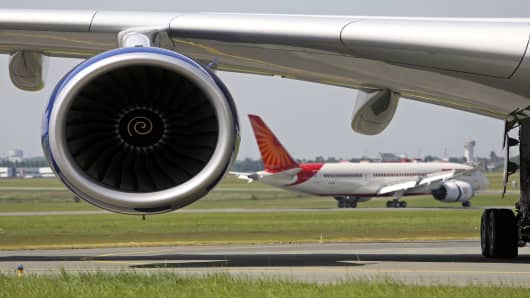Rivals Boeing and Airbus have become more cautious about estimating delivery times for new aircrafts, as both grapple with delivery backlogs, because of production difficulties.
With delivery backlogs for Boeing's Dreamliner and Airbus's A350 and A380 extending to the end of the decade, both companies told CNBC they had tried to move too quickly to create new models, at a faster pace.
"We learned the lessons of the industrial challenges to get it into production," said Airbus Executive Vice President of Engineering Charles Champion, regarding the A350. The wide-body plane is already a year behind in production, as suppliers struggle to produce the necessary composite material parts.
Speaking from the sidelines of the Paris Air Show, Champion said: "The 787 demonstrated that it was not just Airbus: it is not easy to deliver aircraft."
"I think we are now more prudent in how we explain and the key stakeholders have a better understanding of the challenges... We are now much more focused on actually communicating our progress," he added.
(View More: Airbus's New A350 Makes Maiden Flight)
Meanwhile, Boeing announced on Wednesday that delivery of its 737 Max 8 to Southwest Airlines would be delivered early in the third quarter of 2017, rather than at the end of 2017. The 737 Max proved popular last year at the Farnborough Air Show, but orders have declined as airlines sought faster execution and production.
Boeing Marketing Vice President Randy Tinseth admitted there had been failures at the start of the 787 campaign, but with the new 787-10, Boeing feels confident its past production issues are over.
"We had an unrealistic time frame to develop the aircraft. We asked our supplier partners to do more and they really struggled with the capabilities the airplane had to have," Tinseth said. "So we have put a lot of resources in with our suppliers to help them understand better the capabilities, and make sure they are ready."
(Read More: Boeing to Airbus: We've Got You Boxed and Bracketed)
Tinseth, added that the focus at the Paris Air Show on wide-body aircrafts was partly due to pent-up demand after a period of few deliveries.
"There has actually been fewer deliveries of wide-body aircraft in the last ten years than in the ten years before that," he explained.
(Read More: Boeing Fights Back With New Dreamliner Orders)
Tinseth said that Boeing had rejigged its development process, allowing progress on its flagship wide-body plane, the 787, to proceed in a more measures fashion.
"We started this with our second member of the 787 family, the 787-9. We really went back and reinvented our development process," he said.
"Three years ago we set a schedule on the -9, and we had parts coming in to the day we predicted this year. We have really got back our discipline."
(Read More: Boeing CEO: 'Highly Confident' in 787 Battery Fix)


